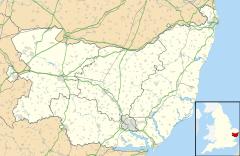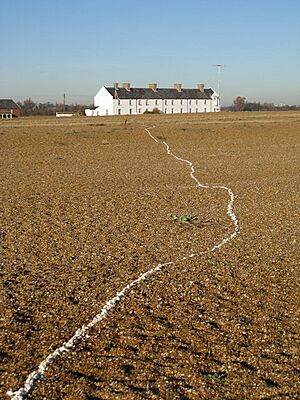Shingle Street facts for kids
Quick facts for kids Shingle Street |
|
|---|---|
 Shingle Street in January 2008. |
|
| Civil parish | |
| District |
|
| Shire county | |
| Region | |
| Country | England |
| Sovereign state | United Kingdom |
| Post town | WOODBRIDGE |
| Police | Suffolk |
| Fire | Suffolk |
| Ambulance | East of England |
| EU Parliament | East of England |
| UK Parliament | |
Shingle Street is a small village located right on the North Sea coast in Suffolk, England. It's about 8 miles (13 km) north-east of Felixstowe and 12 miles (19 km) east of Ipswich. The village sits at the mouth of the River Ore, directly across from the tip of Orford Ness.
Shingle Street is part of the Hollesley area. There is a special facility nearby for young people who have committed crimes, called Hollesley Bay Colony. A report from 2004 warned that Shingle Street is at risk from the sea. It could disappear within 20 years if strong sea defenses are not built to protect it.
Contents
History of Shingle Street
Shingle Street was first settled by people who fished and by river pilots. River pilots are people who guide ships safely along rivers. Many of the original buildings in the village are very old.
Early Buildings and the Lifeboat Inn
In the early 1800s, a Martello tower was built here. This tower later became a home for coastguards, who watch over the coastline. There was also a pub called the Old Beach House, made from wood found on the beach. In 1797, a pilot named Jacob Merrells ran this pub.
Later, in 1810, a new pub was brought to Shingle Street. It was a wooden building made in Ipswich and then floated down the river by barge. This new pub was named the Lifeboat Inn. It was one of many pubs owned by Cobbolds Brewery.
Shingle Street During World War II
During World War II, several buildings in Shingle Street were destroyed. Sadly, the Lifeboat Inn was one of them.
After the war, many strange stories were told about Shingle Street. Some rumors even claimed that the German army had tried to invade there and failed. However, the people living in the village had been moved away in May 1940. This meant there were no witnesses to confirm these stories.
Official documents about these events were kept secret for a long time. But in 1993, after questions were asked in the House of Commons, the papers were released. These documents showed that no German landing had happened at Shingle Street.
Historians now believe these invasion rumors were a clever trick. They helped to make people feel more confident during the war. They also encouraged America to help Britain by providing supplies and support. This type of trick is called black propaganda.
Shingle Street in Culture
Shingle Street has inspired artists and writers.
Music and Books Inspired by Shingle Street
The village was the inspiration for the song "Cloudburst at Shingle Street." This song was by Thomas Dolby and appeared on his 1982 album, The Golden Age of Wireless.
Shingle Street and its old Martello Tower are also featured in the 2020 novel "The Haunted Shore" by Neil Spring.
The Shingle Street Shell Line
In 2005, a stonecutter named Lida Cardozo Kindersley and her friend Els Bottema started something special. They began arranging a line of shells on the beach at Shingle Street. They started this project to help them cope with their shared experience of cancer treatment.
They visited regularly to add more shells. By 2018, their shell line stretched for over 275 meters (about 900 feet). It was made up of 20,000 individual whelk shells! A short film about their work, called 'C shells', was released in 2017. A book titled The Shingle Street Shell Line followed in 2018.
Images for kids
-
The Martello tower






